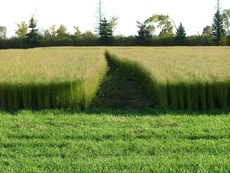Why Use Certified Seed?
Dave Akister, Saskatchewan Seed Growers
for SaskFlax Re-constituted Seed Web Article series
When margins are squeezed and producers are searching for the most economical means of producing a crop, more and more they are asking, “Why should I use certified seed?” The short answer: It is the best insurance a flax producer can put in the ground.
When margins are squeezed and producers are searching for the most economical means of producing a crop, more and more they are asking, “Why should I use certified seed?” The short answer: It is the best insurance a flax producer can put in the ground.

Rarely is the planting environment ideal. Usually it is too hot, too cold, too dry or too wet. Weeds, diseases and insect pests also threaten flax crops. Certified seed is true-to-type. That means the crop it produces is predictable in terms of yield, lodging, disease resistance, maturity and other key characteristics. But genetic purity isn’t the only feature of certified seed.
Certified seed ensures specified germination for even emergence and productive stands. It contains uniform seed size, which provides consistency in planting and crop performance. Optimum seed size promotes seedling vigour and high yields; low disease levels to maintain crop health; and minimal crosscontamination from other crops or different varieties of the same crop. Freedom from other crop seeds, noxious and other weed seeds is controlled by federal regulations to ensure mechanical purity as well. Genetic purity standards ensure that varieties can be chosen that fit the producer’s needs in terms of yield potential, growth habit, disease and insect resistance, maturity and specific markets. Genetic information packed into each seed determines when it will germinate, how well it will handle cold or wet soil, whether it will survive attack by bacteria, viruses and mould, and how much will be harvested if each plant produces to its full potential.
Certified – or what we often call pedigreed – seed carries the technical research from the plant breeder to the end user. It is the source of seed that is used for crop improvement and is the basis of the high reputation for crop quality in Canadian agriculture.
Pedigreed seed is also the only practical means of increasing, ensuring and certifying that a seed stock has high genetic purity and quality standards. This is accomplished by inspection of pedigreed seed crops by trained inspection officers of the Canadian Food Inspection Agency (CFIA), by the administration of genetic crop purity standards by the Canadian Seed Growers Association (CSGA) and by the application of seed quality standards (germination and mechanical purity) of the Canada Seeds Act. Even the cleaning plant that processes it must meet accepted standards and practices monitored by the Canadian Seed Institute (CSI).
At each stage of pedigreed seed production, standards for isolation distances, land-use history, maximum levels of off-types, other crop kinds and weeds have been established by the CSGA. These are the rules all seed growers must follow to maintain the mechanical and genetic purity of their pedigreed seed crops.
The blue “Certified Seed” tag guarantees the seed you buy has gone through all the required multiplication, inspection and cleaning processes to ensure a pure product. You get seed that is true to type, a pure variety with the newest plant genetics, more uniform germination for stronger competition in the fields and an easier harvest, higher yields, and access to end-use specific identity-preserved markets.
Pedigreed seed means just that: the ancestry of the seed can be traced through records maintained by the CSGA all the way back to the plant breeder and the lab from which it originated.
Seed out of someone’s bin that may have been certified a year or two ago can’t offer the same assurances. What else was in the field, the trucks, the combines, the auger or in the bins where it was stored? And what variety is it? In Canada, only pedigreed seed can be legally advertised, sold and designated with a variety name.
Canada’s flax industry has faced market closures and slow-downs since the Triffid event of 2009. The industry collectively implemented the Farm Stewardship Program (testing by many stakeholders along the value chain, directing positive-tested product to non-sensitive markets). Phase Two of the program focuses on re-constituted Seed and recommends the use of certified flax for planting in 2014.
Only the Blue Tag can tell you what you are planting – who developed it; what fields it has been grown in; what weeds may have been in the field where it was grown; when it was produced; who processed it; how pure it is, how well it will germinate, and what variety it is. All that information is verified by third parties and is available to you. If you have a problem, the entire seed system is there to help sort it out. And if you didn’t get the quality seed that you paid for, the resources of the Canadian government are there to protect your interests.
Why use certified seed? In 2014, certified seed means Triffid-free seed. Utilization by all flax producers demonstrates to the world our commitment to quality flax products for all global customers.



